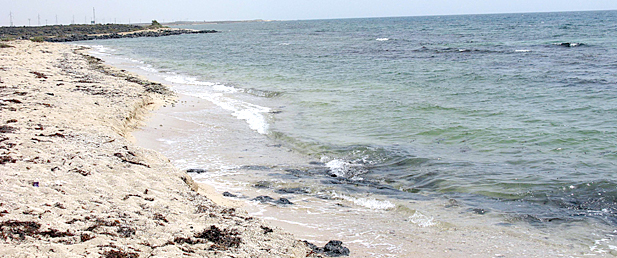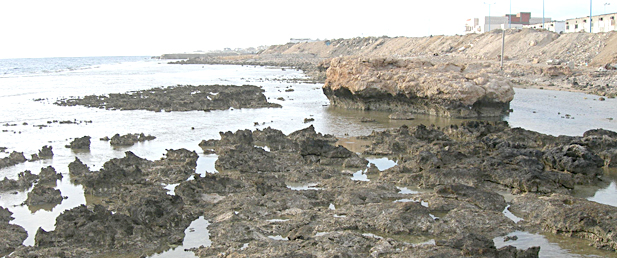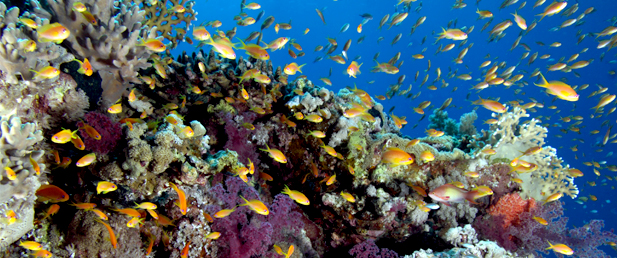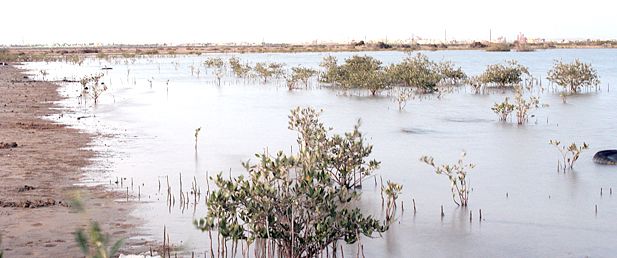Habitats
Sandy beaches

This is the most common supralitoral feature. Due to low nutrients, they have a low species diversity. Typical species include the ghost crab (Ocypode saratan) and the land hermit crab (Coenobita scaevola). In the splash zone members of the mole crabs (Hippidea) are characteristic. Sandy Beaches were sampled at all localities.
Rocky shores

Rocky beaches are more diverse than sandy ones, because they provide substratum for the attachment of algae and sessile invertebrates which can serve predators and scavengers as food. Furthermore, such consumers find enough space for hiding in crevices and under stones.
Rocky shores were sampled at: Al Qunfudhah: (19°10.620’N 041°02.675’E); Intertidal collection of Bryozoa from rocks and debris (well developed); Al Lith – Pier: (20°15.773’N 039°59.544’E); Collecting of several bryozoans directly in the intertidal zone (well developed); Rabigh – Coast Guard Station: (22°58.054’N 038°50.030’E); Al Wajh: (26°15.636’N 036°27.830’E); Al Wajh – Coast Guard Station: (26°15.017’N 036°26.622’E) (well developed); Al-Maqunah – Bay/Shallow water: (28° 27.240’N 34° 45.799’E).
Coral reefs

This habitat is especially rich and well developed in the Red Sea which is renowned worldwide for its thriving coral reefs. The corals offer a multitude of habitats for a rich associated fauna. Not only living corals are of high significance for biodiversity, but the dead colonies and rubbles host a variate fauna in holes and crevices which is not nearly known in detail.
Coral reefs were sampled at: Al Lith – Diving sites: (20°15.055’N 039°57.725’E; 20°15.571’N 039°55.986’E). Many areas were covered with patch reefs, around 40 coral species (well developed); Amaq – Beach, Diving-site: (18° 22.948’N 41° 26.965’E) (fairly well developed); Al Qunfudhah – Diving site: (19°16.813’N 040°53.265’E), high coral diversity, high coral cover, (well developed); Jeddah, Corniche – Diving 1 & 2: (21°38.676’N 039°06.059’E) (fairly well developed); Rabigh – Marine Station beach: (22°47.123’N 038°57.507’E) (fairly well developed); Rabigh – North, Diving: (22°55.925’N 038°50.674’E) (fairly well developed); Rabigh – North Lagoon, Diving: (22°58.007’N 038°51.106’E) (fairly well developed); Rabigh – Masturah, Diving: (23°02.839’N 038°46.621’E) (fairly well developed); Rabigh – Masturah, Diving: (23°04.799’N 038°46.544’E) (fairly well developed); Al Wajh, Rykhah – Diving 1; 2: (26°10.552’N 036°22.448’E; N 26°10.399’ E 036° 25.707’) (fairly well developed); Al Wajh – Diving 1, 2: (26°13.775’N 036°27.263’E) (fairly well developed); Al-Maqunah – Diving 1; 2: (28°26.134’N 034°45.478’E; 28°25.456’N 034°45.298’E) high coral diversity, high; coral cover, (well developed).
Mangroves

Mangroves are also significant for tropical environments as coral reefs are. They are important nursing grounds for commercial prawns and fish. In contrast, they are often not appreciated by the local population and only seen as mosquito breeding grounds. In certain areas overgrazing by camels and goats is a problem. Mangroves have a specialized associate fauna (e. g. fiddler crabs and mud crabs) that disappears if the mangrove stands are destroyed.
Mangroves were sampled at: Farasan island: (16°42.102’N 042°10.462’E) (fairly well developed); Amaq: (18°25.428’N 041°27.147’E) near Qunfudah (fairly well developed); Al Lith: (20°03.094’N 040°25.262’E), (well developed, best one); Rabigh: (22°45.251’N 039°00.361’E) (fairly well developed).


